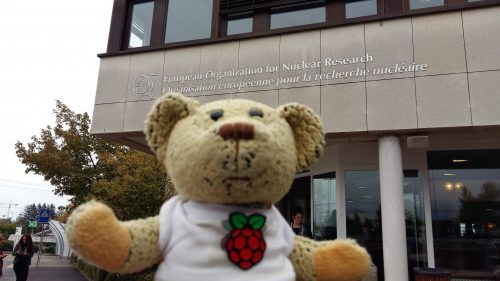CERN Coding Pi Science Event
Laura: MagPi founder and Scottish Pi event organiser extraordinaire Dr. William Bell has sent us this report from the home of the World Wide Web itself…
CERN is the heart of particle physics research, where scientists are working to discover new phenomena using high-energy equipment. These research challenges have driven inventions, such as the World Wide Web and superconducting magnets used by the Large Hadron Collider. Theoretical calculations and experimental analyses are both heavily reliant on computer programming, so it’s a great place to host a Raspberry Pi programming event.

Babbage outside CERN
This year, Brice Copy organised a Coding Pi Science event on the 7th and 8th of October. Working together with long-term Pi supporter Alan McCullagh, he invited three teams to prepare kits to build and program with attendees. To motivate the teams and the other attendees, there were a series of talks on Friday evening; these included a general introduction to the CERN Micro Club and the EU Code Week, as well as a motivational talk on why computer programming is so important for scientific research. Each team then gave an overview of their project, in preparation for the workshop the next day.
On Saturday morning, the teams, volunteers, children, parents, and teachers started to build a muon detector (Muon Hunter), a robotic arm (Poppy Ergo Jr.), or a programmable WiFi car (GianoPi). The idea was to build a kit together with the team leaders and other volunteers, and then take the kit home to program it. These three kits provide different challenges: the Muon Hunter kit requires some soldering and uses a C programming interface, the Poppy Ergo Jr. snaps together and is driven using Snap, and the GianoPi needs soldering and is controlled by Blockly.

Programming Poppy Ergo Jr. in MicroClub Robotics
The Muon Hunter was designed by Mihaly Vadai, in collaboration with the CERN Micro Club. The kit includes two Geiger-Müller tubes to detect ionising radiation, a circuit board that produces the 400 volts needed to bias the tubes and read the signals, and an ARM microcontroller to form the coincidence between the two tubes. The circuit board can be directly connected to a Raspberry Pi to read out the signals and produce plots of the data.
Poppy Ergo Jr. was invented by the Flowers team at Inria Bordeaux, and presented by Stephanie Noirpoudre and Theo Segonds. Their projects are designed to encourage children to learn about computer programming through interacting with robots. The kit includes 3D-printed parts and several servo motors controlled by a Raspberry Pi mounted in the base of the robot. A Camera Module can be used to check the colour of objects, and forms part of their Snap programming examples.
GianoPi was designed by Stefania Saladino. It consist of four servo motors, multi-directional wheels, an ultrasonic sensor, a Pi Zero, a servo control HAT from Adafruit, a WiFi adapter, a battery pack, and some electronics to allow the kit to be easily turned on or off. Brice Copy created the software to interface with the GianoPi using Raspbuggy, which is a Blocky application. Similar to the Poppy Ergo Jr., the GianoPi is controlled over a network connection, allowing the robot to be remotely accessed.

Building GianoPi at the CERN IdeaSquare
It was an engaging weekend of soldering, building, and programming; hopefully, these kits will encourage even more exciting projects in the future. Alan certainly had fun trying to find a good place to put Babbage, too…

Babbage gets everywhere…




6 comments
Alan Mc (IrishFramboise)
We had great fun in Meyrin (just outside Geneva). It was brilliant to have a “bilingual event” in both English and French. A lot of folks made the trip from the other side of the French border to Switzerland (the site straddles the two countries). Strongly recommend the visit to the site if you get the chance.
Huge thanks to Brice and all the volunteers and facilitators. It was already my second event there and a pleasure to be part of! Can’t wait for the next one =o)
Elfen
This is great in furthering what a R-Pi can do besides teaching students about computer technology but rather what one can do with that technology.
Martin Bonner
Pedantic nit-pick: They didn’t invent the Internet at CERN – that was done in America. What CERN invented was the World Wide Web.
Barry
Great stuff. I like the possibilities of remote control via network, lots to think about.
Stefania Martinengo-Saladino
Special thanks to the Robotics Club and La Chataigneraie Campus of the International School of Geneva -where I work – for their precious contributions. You can follow GianoPi’s adventures in our blog: http://libraries.ecolint.ch/chasci/
Alan Mc (Irish Framboise)
+1 !